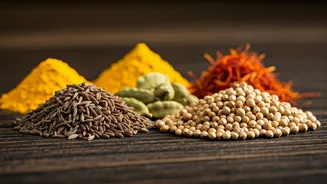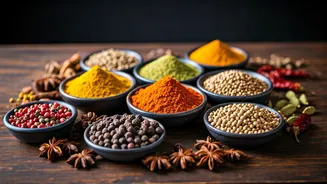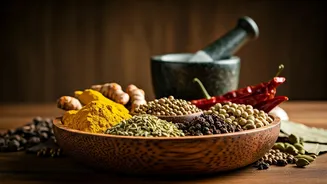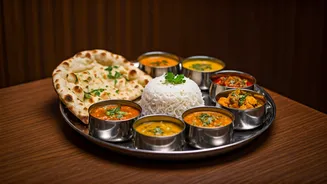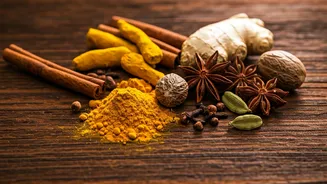Spice Origins & Heritage
The very essence of Indian cooking is intricately woven with a rich tapestry of spices, each holding a unique story that speaks volumes about India's vibrant
history and culinary traditions. Many of these aromatic ingredients trace their roots back to ancient times, flourishing in the fertile lands of India and, over millennia, spreading their influence across the globe. Some, like turmeric, ginger, and cardamom, have been cultivated for thousands of years, becoming integral to Ayurvedic practices and traditional Indian medicine. These spices weren't just for flavoring food; they were valued for their medicinal properties, used to treat ailments, and maintain overall health. The historical trade routes, such as the Silk Road, played a pivotal role in disseminating these spices to other regions, exposing the world to the exotic aromas and flavors of India. These very spices have shaped not only the cuisine, but also the cultural and economic landscape of the nation, making them an essential part of the Indian identity. Their journey, from the fertile soils of the Indian subcontinent to the tables of the world, represents a legacy of flavor, health, and cultural exchange.
Turmeric: The Golden Spice
Turmeric, often called the 'golden spice' due to its vibrant yellow color, holds a special place in Indian cuisine and traditional medicine. Its key active compound, curcumin, is celebrated for its powerful anti-inflammatory and antioxidant properties, making it a popular ingredient in health supplements and remedies. In cooking, turmeric lends its distinctive color and a warm, slightly peppery flavor to dishes, enhancing both the visual appeal and taste. Commonly used in curries, stews, and lentil dishes, turmeric adds a depth of flavor that complements other spices such as cumin, coriander, and chili. Beyond its culinary and medicinal uses, turmeric is also a significant element in religious ceremonies and rituals. It's often used in the preparation of Haldi ceremony, a pre-wedding ritual where a turmeric paste is applied to the bride and groom, believed to cleanse, purify, and bless them. This golden spice isn't just an ingredient; it is a fundamental part of the Indian lifestyle, representing wellness, tradition, and flavor in every use.
Cumin's Aromatic Charm
Cumin, recognizable for its earthy and warm flavor, is a foundational spice in Indian cuisine. The small, boat-shaped seeds, either used whole or ground, are a hallmark ingredient in countless dishes, infusing them with a distinct, aromatic essence. Cumin is a crucial component in many curry powder blends and is frequently used to temper dishes, where it is lightly fried in oil to release its full fragrance before other ingredients are added. Its flavor profile complements a wide array of ingredients, enhancing the taste of vegetables, meats, and lentils alike. Cumin is also known for its digestive properties, and it is traditionally used to aid digestion and reduce bloating, making it a popular spice for promoting gut health. From the tangy flavors of chaat to the hearty stews of the north, cumin adds depth and complexity to the overall experience. The widespread use of cumin highlights its role as an indispensable spice in Indian households. It is a symbol of warmth and comfort, bringing the flavors of home to every meal.
Coriander: A Versatile Spice
Coriander, derived from the seeds of the cilantro plant, presents a flavor profile that is both warming and refreshing. The seeds, which can be used whole or ground, are a staple in Indian cooking, contributing a unique citrusy and slightly floral flavor. In Indian cuisine, coriander often pairs with cumin and other spices, such as turmeric and chili powder, forming complex spice blends that define the flavor profiles of many dishes. Beyond its taste, coriander is also known for its health benefits, including its ability to aid in digestion and boost the immune system. The seeds are often lightly toasted before grinding to amplify their aroma and flavor, adding depth to curries, stews, and dry spice rubs. Coriander’s versatility makes it a valuable spice in both vegetarian and non-vegetarian dishes. It can add complexity to various Indian delicacies, from the subtle nuances of a vegetable curry to the rich and flavorful marinades for meats. It embodies the harmonious blend of flavors and health benefits that characterize the Indian culinary tradition.
Cardamom's Fragrant Notes
Cardamom, known as the 'queen of spices,' is highly valued for its aromatic qualities and distinctive flavor, which adds a touch of sophistication to Indian cuisine. These small pods contain tiny black seeds that offer an exotic, fragrant aroma and a complex flavor profile that combines sweetness, citrus, and a subtle spice. The spice is widely used, and often added to both sweet and savory dishes, from rich biryanis and fragrant rice puddings to flavorful teas and desserts. Cardamom is a key ingredient in masala chai, a beloved beverage in India, where it complements the robust flavors of black tea and milk, creating a comforting and aromatic drink. In Ayurvedic medicine, cardamom is recognized for its digestive properties and is often used to freshen breath and improve overall health. Its use extends beyond the culinary world, as the spice is also incorporated into traditional sweets, such as kulfi and barfi, enhancing the flavors and aromas of these desserts. From its distinct fragrance to its diverse uses, cardamom symbolizes the elegance and richness of Indian spice blends.
Saffron: The Exquisite Spice
Saffron, renowned as one of the world's most expensive spices, lends a vibrant color and distinctive flavor to Indian cuisine. Derived from the stigmas of the Crocus sativus flower, saffron imparts a beautiful golden hue and a subtle, yet complex flavor that is both sweet and slightly bitter. In Indian cooking, saffron is a symbol of luxury and is used sparingly to infuse dishes with its unique essence. The spice is often used in rich dishes such as biryanis, pulaos, and sweets, where it adds both color and an exquisite flavor dimension. Saffron is also revered for its potential health benefits, known for its antioxidant and mood-enhancing properties. Its use is not only culinary; it is also a cultural symbol, used in religious ceremonies and traditional practices. The cultivation of saffron requires significant effort, and its high cost reflects its rarity and the labor-intensive harvesting process. Saffron is a precious spice, enriching Indian cuisine with its unique characteristics, making every dish special.
Chili: Heat and Flavor
Chili peppers play a vital role in Indian cuisine, contributing varying degrees of heat and complexity to dishes. The diverse range of chilies, from mild to intensely hot, allows for a wide spectrum of flavors and spice levels. Chili powder, made from ground chilies, is a common ingredient, enhancing the taste and adding a fiery kick to many dishes. Fresh chilies are also used, either whole or chopped, to add a vibrant heat and a fresh, bright flavor. Different types of chilies are used, each with a unique heat level and flavor profile, from the milder Kashmiri chilies to the fiery Guntur chilies. Chilies are used in various forms: as a primary ingredient in curries, added to dry rubs for meats, and used to create spicy chutneys and pickles. Apart from the heat, chilies also offer health benefits, including their ability to boost metabolism and improve heart health. The widespread use of chilies underscores their significance in creating a culinary experience that is both flavorful and culturally resonant. They give depth and the quintessential fiery taste of India.
Spice Blends & Masalas
Indian cuisine is deeply rooted in the art of blending spices, crafting unique masalas that give a distinctive character to dishes. These masalas, the heart and soul of Indian cooking, are a careful combination of various spices, ground together to achieve a specific flavor profile. Garam masala, a popular blend, typically includes a mix of cinnamon, cloves, cardamom, and black pepper, adding warmth and depth to curries and stews. Another example is the curry powder, a British adaptation, that is often a blend of turmeric, coriander, cumin, and chilies. The creation of a masala is a skill passed down through generations, with each family having its own unique recipe. These blends are used in various forms, from dry rubs for meats to the base of flavorful curries. The complexity and depth of flavor achieved through the use of masalas create a culinary experience that is both rich and satisfying. They embody the harmony and balance that are the essence of Indian cooking. From the subtle nuances of each spice to the well-balanced blend, the masalas show off India's culinary expertise.
Cooking Methods & Usage
The use of spices in Indian cooking is inseparable from the various cooking methods that are employed to bring out the flavors. The technique of tempering, where spices are briefly fried in hot oil before adding other ingredients, is a common practice used to release their aromas. Spices can also be added whole to oil, which infuses the oil with their flavors, before other ingredients are introduced. Ground spices are frequently incorporated into marinades for meats or used as dry rubs, providing intense flavor and color. The use of spice blends like garam masala or curry powder adds depth and complexity. In the preparation of curries, spices are often sautéed with onions, garlic, and ginger to create a flavorful base. The use of various cooking methods allows the spices to interact and release their flavors to perfection. Techniques like slow cooking and dum pukht ensure that spices meld together, enhancing the overall taste and aroma. Indian cuisine's distinctive characteristics are significantly affected by cooking methods, creating culinary artistry that highlights the nuances of each spice.
